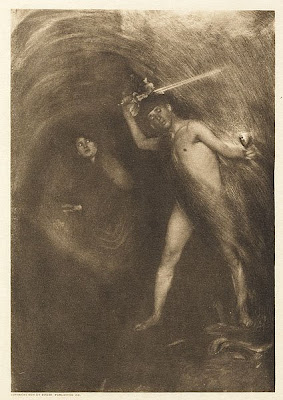




Adelaide Hanscom Leeson (25 November 1875 – 19 November 1931) was an early 20th century artist and photographer who published some of the first books using photography to illustrate literary works.
In late 1903 she began working on a series of photographs to illustrate the classic selection of poems, The Rubaiyat of Omar Khayyam. The concept of illustrating a literary work with fine art photographs was new at that time, and The Rubaiyat was one of the very first American books in this genre. She solicited some then well-known California literary figures, including Joaquin Miller, George Sterling and George Wharton James, as models for the project. She saw the project as both a classic literary publication and as a metaphor for her times. In a newspaper interview she said decided to illustrate The Rubaiyat because it presented "an expression of the struggle of the human soul after the truth, and against the narrowing influence of the dogmatic religions of our time."
In 1905 she published the first edition of The Rubaiyat, and it became a national sensation. Her hometown newspaper proclaimed "The Berkeley Girl whose 'Omar' photos startle the literary critics."[10] Due to the high demand several more editions followed, including a 1914 volume with full-page color plates. The early editions of the book credited only Leeson as the photographer, while later editions said "photographic illustrations by Adelaide Hanscom and Blanche Cummings". Today the work is recognized for its lush beauty and because the first edition is thought to be one of the first publications in America depicting male nudity in photographs.
Unfortunately her success was cut short by the 1906 San Francisco earthquake and fire. Hanscom's studio was completely destroyed, and with it all of the negatives for The Rubaiyat. A small number of prints survived in a safe, but otherwise the only remaining images from this project are in the books themselves. She had to completely start her business and life anew, and since the area where she lived and worked was now mostly uninhabitable she packed her few remaining belongings and moved to Seattle. She soon set up a new studio there with another photographer, Gertrude Wilson, and for the next five years she did commercial portrait works for prominent families in the area. Her photographs often filled the society pages of Seattle's newspaper.
That same year Alfred Stieglitz listed Hanscom as an Associate Member of his Photo-Secession. It is not known how he became aware of her work, and there is no record of the two meeting. Nonetheless, in December 1906 and into early 1907, Stieglitz included two of Hanscom's prints in the Photo-Secession members exhibit in his Little Galleries of the Photo-Secession in New York.
text from Wikipedia











Prosto nemam reči da izrazim svu lepotu na ovim fotografijama.
ReplyDeleteTo je taj zanimljiv pravac foto-piktorijalizma, tu se jako mnogo intervenise na samoj fotografiji a na nekim njenim kasnijim (stavicu i to) se jedva moze i prepoznati da su u pitanju fotografije, odnosno fotogravure. Prelepe su i mislim da jako lepo idu uz Omara, sto bi se reklo - pogodila je notu :) Zao mi je nje, i tog studija koji joj je izgoreo i muza koji je poginuo u ratu i onda na kraju i njene smrti - mislim da ju je pregazio ili udario neki bus ili auto, ne secam se ... Veoma talentovana zena.
ReplyDelete